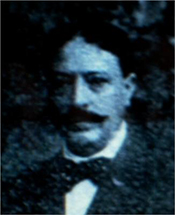BIOGRAPHY - Rubens Santoro (1859 - 1942)

Rubens Santoro spent the first decade of his life in the mountain village of Mongrassano in the Calabria region of southern Italy. Although Calabria is generally a dry and dusty region, the village of Mongrassano is located in the lushly wooded Pollino mountains, making it both cooler and more fertile than much of the surrounding province. The local olive groves have been producing abundant oil since the eighth century BCE when all of southern Italy was part of Magna Grecia; in fact, Mongrassano was founded as a Greek colony during that time.
Santoro’s father, Giovanni Battista Santoro (1809-1895) was an artist and was probably himself born into a family of painters. His work can still be seen in the small coastal town of Fuscaldo where he created several altarpieces in association with other artists in his extended family. Rubens was born on October 26, 1859, the oldest of four children. The elder Santoro, who seems to have made a reasonable living designing religious imagery, educated all of his sons to be painters; it is not known whether he also trained his only daughter, Carolina. They learned basic drawing as well as architectural drawing, landscape painting and marine painting in the family studio.
In 1869 the family moved to Naples, perhaps because there wasn’t sufficient work in Mongrassano or because there were more potential patrons in the larger city. Once the family settled into their newly urban life, Rubens was sent to the Accademia di Belli Artes to study painting. There he studied with Domenico Morelli (1823-1901), a leader of the Neapolitan school of painting at the time. Morelli worked in a somewhat curious blend of Realism and traditional classicism; he had traveled through most of Europe in the 1850s, spending time in Paris where he admired the historical paintings of Paul Delaroche, and in Rome where he was fascinated with the Austrian Nazarene painters. In Florence, he had participated in the discussions of Realism sponsored by the Macchiaioli artists. When he returned to Naples, however, Morelli’s exposure to this myriad of contemporary art movements and ideas made him an ideal teacher, even though his own work remained quite traditional.[i]
Santoro was also influenced by landscape and genre painter, Eduardo Dalbono, (1841-1915) who was living and working in Naples prior to 1878. Dalbono was a regular exhibitor at the independent artists’ society, the Società Promotrice di Belle Arti, and he may well have encouraged the young Santoro to show his painting titled A Girl Who Laughs at Promotrice in 1875.
In contrast to his brother Francesco, who became a professor of painting at the Instituto di Belli Artes in 1877, Santoro spent most of his time painting southern Italian landscapes. In 1877, he was traveling the Amalfi coast and selling the resulting paintings to the Goupil Gallery in Paris; that same year, he also exhibited Marina di Maiuri (Maiuri Harbor) and Grotta degli Zingari (Grotto of the Gypsies) at the annual Naples exhibition. One year later, he began exhibiting his work in Paris.
During the next two decades, Santoro participated in a number of national and international expositions, beginning with the Esposizione nazionale de belle arti (National Exposition of Fine Arts) in Turin in 1880 and 1884. By 1886 he had received an honorable mention at the Salon in Paris; and in 1893, his work was on display in Chicago at the World’s Columbian Exposition. His work was shown at the Paris Salon consistently from 1904-1909, and he received a silver medal at the annual exhibition in Barcelona in 1911. Clearly, Santoro was persistent and smart about getting as much exposure for his art as possible.
Although the date is not well documented, Santoro moved to Venice at some point between 1890 and World War I. This was period when tourism in the city was increasing significantly—lured by the light, the beauty of the urban architecture, and the charm of a floating city. Painters too were enchanted by the visual delight that the city offered. Like the eighteenth century vedute painters, Antonio Canaletto and Francesco Guardi, nineteenth and twentieth century artists also found a steady market for their images of La Serenissima.
In the decade before World War I, Santoro’s paintings of Venice appear in several New York auction catalogues, suggesting that interest in his work from American collectors was growing. Although most of his sales were to private patrons, his painting titled Arabs appeared in the Cincinnati Art Museum Catalogue of the Permanent Collection of Paintings in 1915. [ii]
Unlike his non-Italian colleagues, Santoro was able to remain in Venice during the war and continue to work. His sunlit scenes belied the horror that was occurring in northern France and Belgium, which may have made them even more attractive to middle-class art collectors who were weary of the relentless nightmare of trench warfare. At some point during the 1920s, Santoro apparently made several trips to England, perhaps at the invitation of clients who had purchased his canvases during a stay in Venice in happier times. It should be noted that a number of museums in large industrial cities in England own paintings by Santoro, almost always the gift of a local industrialist art collector.
After his sojourn in England, and another extended stay in Paris, Santoro returned to Naples where he continued to paint until his death in 1942.
Janet Whitmore, Ph.D.
Selected Museums
Aberdeen Art Gallery and Museums
Baltimore Museum of Art, Maryland
Cincinnati Art Museum, Ohio
Cooper Gallery, Barnsley, South Yorkshire
Manchester Art Gallery, Manchester, UK
Millennium Gallery, Sheffield, South Yorkshire
Museo Civico, Turin, Italy
Museo Nazionale, Reggio di Calabria, Italy
[i] Shepherd & Derom Galleries, New Acquisitions: European Paintings, Watercolors, Drawings and Sculpture, 1780-1960 (New York: 2009) No. 23. Auction catalogue.
[ii] Cincinnati Art Museum, Catalogue of the Permanent Collection of Paintings (Cincinnati, Ohio, 1915) 57.
